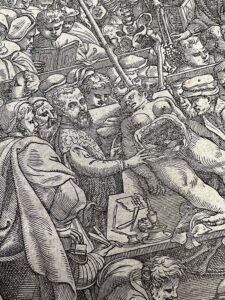Andreas Vesalius’ De humani corporis fabrica (1543)
By Laura, 4th Year medical student at Exeter University

De humani corporis fabrica is Latin for ‘on the fabric of the human body’. The author, Andreas Vesalius (1514-1564), was a Flemish anatomist who advocated for human dissection instead of animal dissection as a means of understanding human anatomy more accurately than his predecessors. He is often referred to as the ‘father of modern anatomy’ for revolutionising this field of medicine.
The illustrations in this book are printed using a technique known as woodcut which requires the artist (not Vesalius himself) to hand-carve each intricate image onto a piece of wood. There are over 200 woodcut illustrations across the 7 volumes – it must have been a very time-consuming task. However, Vesalius believed that direct observation was essential for teaching anatomy so it was imperative that they were included.
Interestingly, all the bodies illustrated in this book are posed in a unique, lifelike manner, often with scenic backgrounds. During the Renaissance period there was a celebration of the complexity and beauty of the human body, and Vesalius’ anatomical illustrations reflect this.